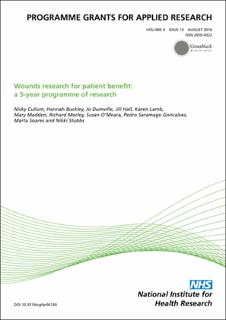| dc.contributor.author | Cullum, N. | |
| dc.contributor.author | Buckley, H. | |
| dc.contributor.author | Dumville, J. | |
| dc.contributor.author | Hall, J. | |
| dc.contributor.author | Lamb, K. | |
| dc.contributor.author | Madden, M. | |
| dc.contributor.author | Morley, R. | |
| dc.contributor.author | O’Meara, S. | |
| dc.contributor.author | Goncalves, P. S. | |
| dc.contributor.author | Soares, M. | |
| dc.contributor.author | Stubbs, N. | |
| dc.date.accessioned | 2021-05-27T13:12:04Z | |
| dc.date.available | 2021-05-27T13:12:04Z | |
| dc.date.issued | 2016 | |
| dc.identifier.citation | Cullum, N., Buckley, H., Dumville, J., Hall, J., Lamb, K., Madden, M., Morley, R. … Stubbs, N. (2016). Wounds research for patient benefit: a 5-year programme of research. Programme Grants for Applied Research, 4(13). | en_US |
| dc.identifier.uri | https://hdl.handle.net/11250/2756704 | |
| dc.description.abstract | Background
Complex wounds are those that heal by secondary intention and include lower-limb ulcers, pressure ulcers and some surgical wounds. The care of people with complex wounds is costly, with care mainly being delivered by community nurses. There is a lack of current, high-quality data regarding the numbers and types of people affected, care received and outcomes achieved.
Objectives
To (1) assess how high-quality data about complex wounds can be captured effectively for use in both service planning and research while ensuring integration with current clinical data collection systems and minimal impact on staff time; (2) investigate whether or not a clinical register of people with complex wounds could give valid estimates of treatment effects, thus reducing dependence on large-scale randomised controlled trials (RCTs); (3) identify the most important research questions and outcomes for people with complex wounds from the perspectives of patients, carers and health-care professionals; (4) evaluate the potential contributions to decision-making of individual patient data meta-analysis and mixed treatment comparison meta-analysis; and (5) complete and update systematic reviews in topic areas of high priority.
Methods
To meet objectives 1 and 2 we conducted a prevalence survey and developed and piloted a longitudinal disease register. A consultative, deliberative method and in-depth interviews were undertaken to address objective 3. To address objectives 4 and 5 we conducted systematic reviews including mixed treatment comparison meta-analysis.
Results
From the prevalence survey we estimated the point prevalence of all complex wounds to be 1.47 per 1000 people (95% confidence interval 1.38 to 1.56 per 1000 people). Pressure ulcers and venous leg ulcers were the most common type of complex wound. A total of 195 people with a complex wound were recruited to a complex wounds register pilot. We established the feasibility of correctly identifying, extracting and transferring routine NHS data into the register; however, participant recruitment, data collection and tracking individual wounds in people with multiple wounds were challenging. Most patients and health professionals regarded healing of the wound as the primary treatment goal. Patients were greatly troubled by the social consequences of having a complex wound. Complex wounds are frequently a consequence of, and are themselves, a long-term condition but treatment is usually focused on healing the wound. Consultative, deliberative research agenda setting on pressure ulcer prevention and treatment with patients, carers and clinicians yielded 960 treatment uncertainties and a top 12 list of research priorities. Of 167 RCTs of complex wound treatments in a systematic review of study quality, 41% did not specify a primary outcome and the overall quality of the conduct and reporting of the research was poor. Mixed-treatment comparison meta-analysis in areas of high priority identified that matrix hydrocolloid dressings had the highest probability (70%) of being the most effective dressing for diabetic foot ulcers, whereas a hyaluronan fleece dressing had the highest probability (35%) of being the most effective dressing for venous ulcers; however, the quality of this evidence was low and uncertainty is high.
Conclusions
Complex wounds are common and costly with a poor evidence base for many frequent clinical decisions. There is little routine clinical data collection in community nursing. A prospective complex wounds register has the potential to both assist clinical decision-making and provide important research evidence but would be challenging to implement without investment in information technology in NHS community services. Future work should focus on developing insights into typical wound healing trajectories, identifying factors that are prognostic for healing and assessing the cost-effectiveness of selected wound treatments. | en_US |
| dc.publisher | Programme Grants for Applied Research | en_US |
| dc.subject | wounds | en_US |
| dc.subject | pasientsikkerhet | en_US |
| dc.subject | trykksår | en_US |
| dc.title | Wounds research for patient benefit: a 5-year programme of research | en_US |
| dc.type | Journal article | en_US |
| dc.source.volume | 4 | en_US |
| dc.source.journal | Programme Grants for Applied Research | en_US |
| dc.source.issue | 13 | en_US |
| dc.identifier.doi | https://doi.org/10.3310/pgfar04130 | |
| dc.description.localcode | måsjekkes | |
